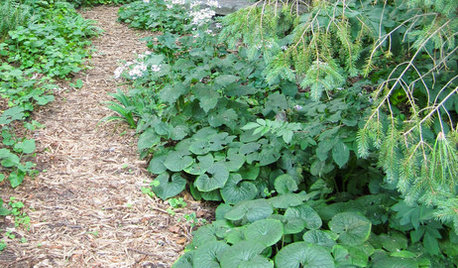Add potter's clay to sandy soil?
paulns
17 years ago
Related Stories

GARDENING GUIDESHow to Stop Worrying and Start Loving Clay Soil
Clay has many more benefits than you might imagine
Full Story
GARDENING GUIDESGardening Solutions for Dry, Sandy Soils
Has your desert or beachy site withered your gardening creativity? Try these ideas for a beautiful, easy-care landscape
Full Story
GARDENING GUIDESHave Acidic Soil in Your Yard? Learn to Love Gardening Anyway
Look to acid-loving plants, like conifers and rhododendrons, to help your low-pH garden thrive
Full Story
GARDENING GUIDESThe Poop Scoop: Enrich Your Soil With Good Old Manure
Get over the ick factor already — this natural super-ingredient for soil has so many benefits, you'll wonder why you ever went chemical
Full Story
GARDENING GUIDESInvite Cellophane Bees to Your Garden by Providing Patches of Bare Soil
Look for cellophane bees (Colletes) pollinating flowering trees and shrubs in U.S. gardens this spring
Full Story
GARDENING GUIDESGet the Dirt on Your Garden’s Soil
Understand how your soil supports your plants so you can ensure your garden’s success
Full Story
GARDENING GUIDES6 Native Ground Covers for Tough, Dry Spots
Sun beating down on your sandy gravel? Thick shade darkening your clay soil? There’s a ground cover here for you
Full Story
GARDENING GUIDESGreat Design Plant: Anemone Canadensis Adds Pizzazz to Water’s Edges
Plant Canadian anemone along pond, lake or stream edges for a splash of white flowers in late spring
Full Story
EDIBLE GARDENSHow to Add an Apple Tree to Your Edible Garden
Readily available, beautiful and fragrant, apple trees offer four-season interest along with crisp, juicy fruit
Full Story
GROUND COVERSAsarum Canadense Adds Masses of Green to Woodland Gardens
Plant Canadian wild ginger in the eastern U.S. for a shade-loving native ground cover with spring flowers
Full StoryMore Discussions







blutranes
bpgreen
Related Professionals
Baltimore Landscape Architects & Landscape Designers · Brentwood Landscape Architects & Landscape Designers · Kenmore Landscape Architects & Landscape Designers · Port Royal Landscape Architects & Landscape Designers · Goodlettsville Landscape Contractors · Paramus Landscape Contractors · Santa Maria Landscape Contractors · Stallings Landscape Contractors · Weymouth Landscape Contractors · Carmel Decks, Patios & Outdoor Enclosures · Grandview Decks, Patios & Outdoor Enclosures · Hialeah Decks, Patios & Outdoor Enclosures · Knoxville Decks, Patios & Outdoor Enclosures · Lincolnton Decks, Patios & Outdoor Enclosures · San Diego Decks, Patios & Outdoor EnclosurespaulnsOriginal Author
remuda1
tiffy_z5_6_can
maggiemae_2006
althea_gw
paulnsOriginal Author
Kimmsr
swanz
Sherry_AK
pls8xx
shrubs_n_bulbs
paulnsOriginal Author
davidbooth65
happyday
Sherry_AK
rhizo_1 (North AL) zone 7
pablo_nh
paulnsOriginal Author